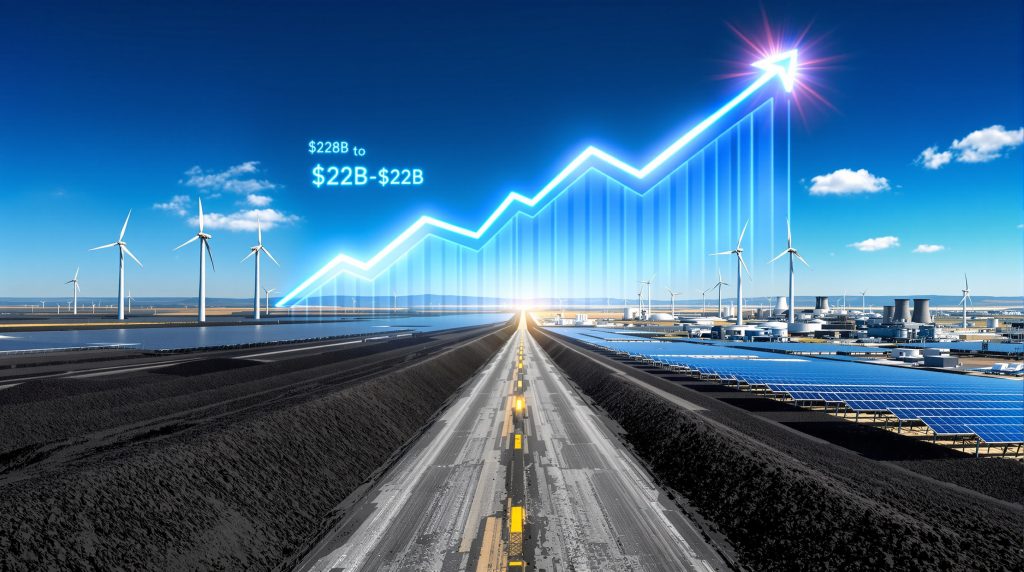Australia's Coal Mine Extension Approval: Balancing Economy and Climate Commitments
Australia's recent approval of Glencore's Ulan coal mine extension has reignited the national debate about fossil fuel production versus climate action. The government's decision allows for an additional 18.8 million tons of coal extraction and extends operations until 2035, highlighting the complex relationship between Australia's resource-based economy and its climate ambitions.
Understanding the Ulan Mine Extension
The Ulan mine extension, recently approved by the Australian government, represents a significant development in the country's ongoing coal production strategy. Located in central-west New South Wales near the village of Ulan, this Glencore-operated facility has received permission to extract an additional 18.8 million tons of thermal coal and operate for two more years until 2035.
Glencore has characterized this approval as a "minor change to the current mine plan" that ensures continued employment for the existing workforce at the complex. This framing aims to minimize the perceived environmental impact while emphasizing economic stability for the region.
The extension specifically targets thermal coal production, which is primarily used for electricity generation in international markets. This type of coal is different from metallurgical coal, which is used in steel production and has fewer immediate alternatives in industrial processes.
The Economic Context Behind Australia's Decision
Australia's Position in Global Coal Markets
Australia maintains its position as the world's second-largest thermal coal exporter after Indonesia, with exports reaching 209 million tons in 2024. This significant market share makes coal a crucial component of Australia's export economy, despite growing international pressure to reduce fossil fuel dependency.
The quality of Australian thermal coal is frequently cited by industry proponents as superior to that of competing nations. This higher energy content and lower impurity levels theoretically result in fewer emissions per unit of energy produced when the coal is combusted, though all coal burning contributes substantially to global carbon emissions.
Employment and Regional Economic Impacts
The Ulan extension approval secures continued employment for hundreds of workers at the complex, providing economic stability for the central-west NSW region where mining remains a significant employer. Mining communities like those surrounding Ulan have historically built their entire economic foundation around resource extraction, making transition planning particularly challenging.
Regional councils in mining areas frequently support extension approvals, citing the flow-on economic benefits to local businesses, housing markets, and community services that depend on mining wages and operations. This creates political pressure on decision-makers at both state and federal levels.
Projected Decline in Coal Export Value
Despite the extension approval, Australia's thermal coal export earnings are projected to decrease significantly:
- Current (2025): Approximately A$32 billion
- Forecast (2027): Approximately A$22 billion (31% decline)
This projected 31% drop in revenue over just two years signals the challenging market conditions facing Australian thermal coal, driven by international decarbonization efforts and competition from renewable energy solutions. Export volumes are also expected to gradually decline as major importing countries like Japan, South Korea, and China implement their own energy transition strategy.
The declining revenue forecasts raise questions about the long-term economic viability of coal mining extensions, particularly as financing for new coal projects becomes increasingly difficult to secure from international banks and investors.
Why Has This Decision Sparked Climate Backlash?
Contradictions in Australia's Climate Messaging
The approval has exposed a fundamental tension in Australia's climate policy approach. On the international stage, Australia is actively competing with Turkey to host the 2026 UN climate summit, positioning itself as a committed participant in global climate action. Simultaneously, the government continues approving extensions to fossil fuel projects that will contribute to greenhouse gas emissions well into the 2030s.
This disconnect between international positioning and domestic policy decisions creates what critics call "climate diplomacy whiplash" – where Australia's statements in international forums appear at odds with its resource development approvals.
The approval also comes as Australia's domestic emissions reduction targets face increasing scrutiny. While the government has legislated a 43% reduction in emissions by 2030 (compared to 2005 levels), this target only accounts for emissions produced within Australia's borders, not those resulting from the combustion of exported fuels.
Environmental Groups' Response
Climate advocacy organizations have responded strongly to the decision. Amanda McKenzie, CEO of the Climate Council, directly called out the contradiction, stating it's "nonsensical to cut climate pollution with one hand while approving new coal projects with the other."
The Australian Greens Party has formally condemned the extension as undermining climate action, with parliamentary representatives highlighting how the approval contradicts scientific advice on fossil fuel development. The Greens' growing influence in Australian politics, particularly in the Senate, has increased pressure on the government regarding fossil fuel approvals.
Environmental legal groups are exploring potential challenges to the approval, focusing on whether climate impacts were adequately considered in the assessment process. Previous coal project approvals have faced legal challenges based on intergenerational equity principles and greenhouse gas impact assessments.
How Does This Fit Into Australia's Climate Commitments?
The Paris Agreement requires signatories to take progressively stronger climate action to limit global warming to 1.5°C. Environmental experts argue that approving new coal extraction directly contradicts this obligation, as climate models indicate most existing fossil fuel reserves must remain unburned to meet climate targets.
A key issue in the debate involves "scope 3 emissions" – greenhouse gases released when Australian coal is burned overseas. While these emissions aren't counted in Australia's domestic targets, they contribute significantly to global climate change. The total lifecycle emissions from the additional 18.8 million tons of coal will far exceed the direct emissions from the mining operation itself.
The approval also complicates Australia's efforts to position itself as a clean energy superpower, with critics arguing that simultaneously expanding both renewable energy and fossil fuel production sends mixed signals to international partners and investors.
What Are the Political Dimensions of Australia's Coal Policy?
The Albanese Government's Balancing Act
Prime Minister Anthony Albanese's administration faces competing pressures that make coal policy particularly challenging. The Labor government must balance:
- Promoting Australia's climate credentials internationally
- Supporting traditional resource industries domestically
- Addressing growing voter concern about climate change
- Maintaining economic stability in regional communities
- Responding to energy security concerns
This balancing act is further complicated by Labor's electoral vulnerability in both coal mining regions and inner-city areas where climate concern is high. The government has attempted to frame its approach as supporting a "responsible transition" rather than an abrupt shift away from fossil fuels.
Industry Arguments for Australian Coal
The mining sector consistently presents several arguments in favor of Australian coal production:
- Australian coal is of higher quality and produces fewer emissions than competitors
- Regulatory delays risk jobs and Australia's reputation as a reliable trading partner
- Global demand for thermal coal will continue regardless of Australian supply decisions
- Premature closure of mines could lead to "carbon leakage" where production shifts to countries with lower environmental standards
Glencore specifically characterized the Ulan extension as a "minor change to the current mine plan" that provides ongoing employment for the current workforce, emphasizing continuity rather than expansion.
The Growing Influence of Climate Politics
The political landscape around fossil fuels is shifting in Australia, with several key trends:
- Increasing parliamentary influence of the Australian Greens, who hold the balance of power in the Senate
- Growing climate voting bloc among younger generations
- Rising public concern about extreme weather events linked to climate change
- Emergence of climate-focused independent candidates winning traditionally safe seats
These shifts are creating new political pressures on both major parties, with mining communities and climate-concerned voters pulling policy in different directions. The 2022 federal election saw significant gains for climate-focused candidates, suggesting this tension will likely intensify.
What Legal Challenges Face Coal Mine Approvals?
Precedent-Setting Court Decisions
Recent years have seen Australian courts increasingly willing to scrutinize fossil fuel project approvals:
- The landmark Rocky Hill coal mine case established climate impacts as valid grounds for rejecting mining applications
- Several projects have faced legal challenges based on inadequate consideration of scope 3 emissions
- Courts have required more comprehensive assessment of cumulative impacts across multiple projects
- Legal challenges now frequently cite international climate obligations as relevant considerations
These legal precedents have created additional hurdles for coal project approvals, with environmental groups increasingly turning to the courts to enforce climate considerations in planning decisions.
Regulatory Framework Evolution
Australia's environmental approval process continues to evolve in response to climate concerns:
- Federal and state approval frameworks are increasingly incorporating climate impact assessments
- Greater consideration of international obligations is being required in environmental impact statements
- Regulators are facing pressure to consider the cumulative impacts of multiple projects
- Conditions attached to approvals are becoming more stringent regarding emissions mitigation
The Ulan extension approval may face scrutiny over whether these evolving standards were adequately applied during the assessment process, particularly regarding scope 3 emissions and cumulative impacts.
How Might This Decision Affect Australia's Energy Future?
The Transition Timeline Question
The Ulan extension raises questions about Australia's timeline for transitioning away from fossil fuels:
- The extension pushes coal production at this site through 2035
- This timeline may conflict with accelerated decarbonization scenarios needed to meet climate goals
- It signals potential delays in Australia's overall energy transition
- The extension creates additional economic dependencies that may complicate transition planning
Energy market analysts note that extending coal operations into the mid-2030s creates potential stranded asset risks, as global commodity tariffs and declining demand for thermal coal are projected to impact markets significantly before that timeframe as major importing countries implement their own energy transitions.
Investment Signals and Market Response
The approval sends mixed signals to energy investors about Australia's long-term direction:
- Continued support for fossil fuel projects despite declining economic forecasts
- Uncertainty about the pace of renewable energy transition
- Questions about stranded asset risks for long-term fossil fuel investments
- Competing narratives about Australia's future energy mix
Investment in Australia's energy sector increasingly requires clear policy signals, with international capital becoming more selective about supporting fossil fuel projects. The extension approval may temporarily reassure traditional mining investors but could deter those focused on clean energy transformation.
What Are the International Implications?
Australia's Global Climate Reputation
The decision impacts how Australia is perceived in international climate forums:
- Potential complications for Australia's bid to host the UN climate summit
- Questions about Australia's commitment to emissions reduction
- Comparisons with other developed nations' fossil fuel policies
- Scrutiny from international climate advocacy organizations
Climate diplomats note that hosting a UN climate summit requires demonstrating policy consistency and leadership. Turkey, Australia's competitor for hosting rights, could potentially highlight Australia's continued fossil fuel approvals as evidence of insufficient climate commitment.
Trade and Diplomatic Considerations
Australia's coal export decisions have broader implications:
- Trading relationships with major coal importers like Japan, China, and India
- Alignment with climate-focused trade policies emerging in Europe and North America
- Positioning in the Indo-Pacific region's energy transition
- Vulnerability to carbon border adjustment mechanisms being implemented by trading partners
As major economies implement carbon pricing and border adjustments, Australia's export strategy faces increasing international pressure. The European Union's Carbon Border Adjustment Mechanism (CBAM) represents the beginning of a trend that could affect Australia's coal exports as importing countries factor emissions into trade policies.
What Does This Mean for Australia's Future Climate Policy?
The Path Forward: Balancing Competing Priorities
Australia faces critical decisions about how to:
- Support communities currently dependent on fossil fuel industries
- Accelerate renewable energy development
- Meet increasingly stringent international climate expectations
- Maintain economic stability during energy transition
- Develop new export industries to replace declining coal revenue
The approval of the Ulan extension highlights the challenges in balancing these competing priorities, with short-term economic and employment considerations often weighted against longer-term climate commitments.
Policy Reform Possibilities
The controversy may accelerate discussions about:
- More comprehensive climate impact assessments for resource projects
- Clearer transition pathways for fossil fuel-dependent regions
- Enhanced support for renewable energy zones and clean export industries
- Reform of environmental approval processes to better incorporate climate considerations
- Development of transition authorities to coordinate regional economic diversification
Regional transition planning becomes increasingly critical as coal supply challenges and commodity price impact continue to reshape markets while global trends simultaneously signal long-term decline. Several Australian states are establishing transition authorities to coordinate this complex process.
FAQs About Australia's Coal Mine Approvals
How do coal mine approvals affect Australia's emissions targets?
While Australia's domestic emissions targets focus on emissions produced within its borders, approving coal mines that export to international markets contributes significantly to global emissions. This creates a disconnect between domestic climate policies and international climate impact.
The accounting distinction between domestic emissions and those from exported products allows Australia to claim progress on climate targets while simultaneously approving projects that will result in substantial emissions when the coal is burned overseas.
What alternatives exist for coal-dependent communities?
Australia is developing several pathways for coal-dependent regions:
- Renewable energy zones in former coal regions
- Green hydrogen production hubs
- Critical minerals processing facilities
- Land rehabilitation and environmental management
- Manufacturing using renewable energy
- Tourism and agricultural diversification
Successful transition requires early planning, significant investment, workforce training programs, and community engagement to ensure new industries provide comparable employment opportunities.
How does Australian coal compare to other global suppliers?
Australian thermal coal typically has higher energy content and lower impurities than coal from some competing nations, which the industry argues makes it relatively less emissions-intensive when burned. However, climate scientists emphasize that all coal combustion contributes substantially to greenhouse gas emissions.
The quality difference between Australian coal and that from competitors like Indonesia amounts to approximately 10-15% lower emissions per unit of energy, which does not fundamentally alter the climate impact of continued coal use.
What is the expected lifespan of Australia's coal export industry?
Economic forecasts suggest Australia's thermal coal exports will gradually decline over the coming decades as major importers implement their own decarbonization policies. The speed of this transition remains uncertain and dependent on global energy market developments.
Most energy transition scenarios project significant decline in thermal coal demand by the 2030s, raising questions about the economic viability of mine extensions that continue production beyond this timeframe. The projected 31% drop in export earnings between 2025 and 2027 indicates this decline may be accelerating faster than previously anticipated.
Further Exploration:
Readers interested in learning more about Australia's energy and climate policies can also explore related educational content about developments in the global mining and resources sector, particularly regarding transition planning for resource-dependent communities and the evolution of energy markets in the Asia-Pacific region.
Want to Identify the Next Major ASX Discovery Opportunity?
Discover how mining investors are gaining a crucial market edge through real-time alerts on significant mineral discoveries with Discovery Alert's proprietary Discovery IQ model. Explore historic discoveries and their exceptional returns on the Discovery Alert discoveries page and position yourself ahead of the market.




